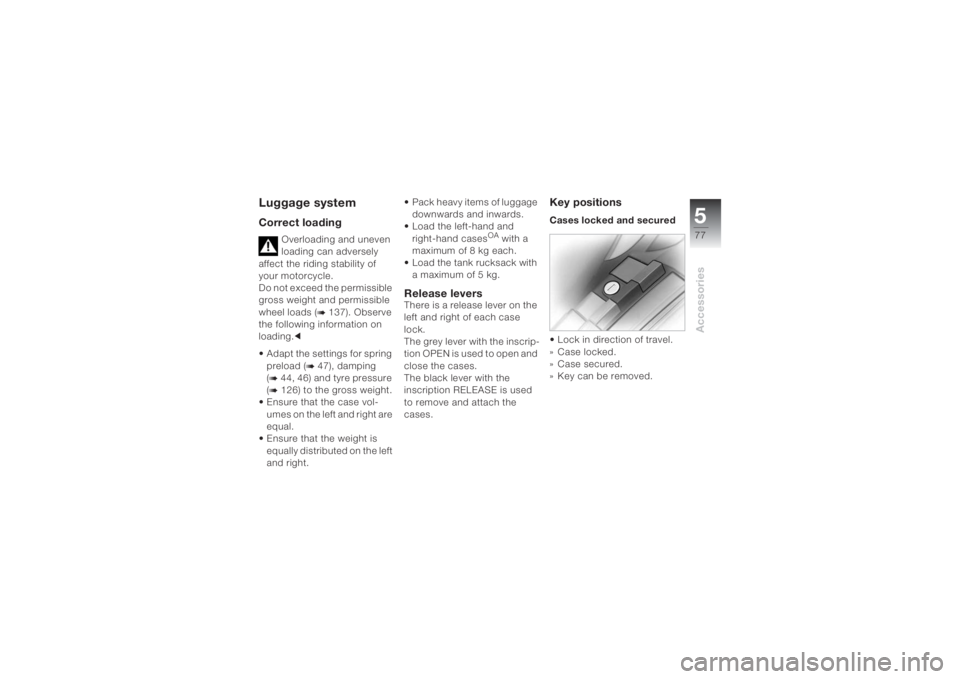Page 63 of 162

461Riding
Placing the motorcycle
on its side stand
The motorcycle cannot
stand securely on uneven
ground.
Ensure that the stand is set
down on an even and firm
surface.c
When sitting on the
motorcycle:
• Switch off the engine.
• Apply the handbrake.
• Place the motorcycle verti-
cally and balance it out.
• Use your left foot to fold the
side stand towards the side
up to its limit position (arrow).
• Slowly lean the motorcycle
on the stand, relieving the
load, and dismount to the
left.• Turn the handlebars to the
full left or right lock position.
• Check that the motorcycle is
standing firmly.
If the motorcycle is on the
side stand, the surface of
the ground determines wheth-
er it is better to turn the han-
dlebars to the left or right.
However, the motorcycle is
more stable on a level surface
with the handlebars turned to
the left than with the handle-
bars turned to the right.
On level ground, always turn
the handlebars to the left to set
the steering lock.cThe side stand is only
configured for the weight
of the motorcycle.
Do not sit on the motorcycle
with the side stand
extended.c
On uphill gradients,
position the motorcycle
in the "uphill" direction and
engage 1st gear.c
Page 67 of 162
465Riding
Placing the motorcycle
on the centre stand
OA
The motorcycle cannot
stand securely on poor
ground.
Ensure that the stand is set
down on a firm and even
surface.c
• Switch off the engine.
• Dismount, keeping your left
hand on the handlebar grip.
• With your right hand, take
hold of the pillion passenger
grab handle or rear frame.
• Place your right foot on the
actuating pin of the centre
stand and press the centre
stand downwards until the
rolling feet make contact
with the ground.• Place your full body weight
on the centre stand and at
the same time pull the
motorcycle backwards
(arrow).
• Check that the motorcycle is
standing firmly.
The centre stand can fold
in if there is excessive
motion and lead to the vehicle
falling over.
Do not sit on the motorcycle
with the centre stand
extended.c
Page 72 of 162

Riding470
the motorcycle’s technical
braking capacity will minimise
braking distances noticeably,
even when road conditions are
poor.When riding straight
ahead, the BMW Integral ABS
enables secure, optimised
emergency braking which
corresponds to the
circumstances.
Reserves for safety
The potentially shorter braking
distances which BMW Integral
ABS permits must not be used
as an excuse for careless rid-
ing. ABS is primarily a means
of ensuring a safety margin in
genuine emergencies.
Take care when cornering.
When you apply the brakes on
a corner, the motorcycle’s
weight and momentum take over and even BMW Integral
ABS is unable to counteract
their effects.
Integral braking
The integral braking function
activates the front and rear
brakes jointly, which means
that both wheels are braked
when one brake lever is
pressed. The electronics in the
BMW Integral ABS controls
the braking force distribution
between the front and rear
brakes. Braking-force distribu-
tion depends on load and is
recalculated every time the
ABS controller comes into
action. Partial integral braking
Your motorcycle is fitted with
partial integral braking. In this
partially integral brake configu-
ration, the integral braking
function is activated only when
you pull the handbrake lever.
The footbrake lever acts only
on the rear brake.
Braking power assistance
On braking, BMW Integral
ABS boosts the brake force on
the wheel by means of a
hydraulic pump. By boosting
the braking force in this way,
BMW Integral ABS achieves
higher braking efficiency than
standard brake systems.
Page 79 of 162

577Accessories
Luggage systemCorrect loading
Overloading and uneven
loading can adversely
affect the riding stability of
your motorcycle.
Do not exceed the permissible
gross weight and permissible
wheel loads (
b 137). Observe
the following information on
loading.c
• Adapt the settings for spring
preload (
b 47), damping
(
b 44, 46) and tyre pressure
(b 126) to the gross weight.
• Ensure that the case vol-
umes on the left and right are
equal.
• Ensure that the weight is
equally distributed on the left
and right.• Pack heavy items of luggage
downwards and inwards.
• Load the left-hand and
right-hand cases
OA with a
maximum of 8 kg each.
• Load the tank rucksack with
a maximum of 5 kg.
Release leversThere is a release lever on the
left and right of each case
lock.
The grey lever with the inscrip-
tion OPEN is used to open and
close the cases.
The black lever with the
inscription RELEASE is used
to remove and attach the
cases.
Key positionsCases locked and secured • Lock in direction of travel.
» Case locked.
»Case secured.
» Key can be removed.
Page 80 of 162
Accessories578
Cases not locked and
secured • Turn the lock on the right-
hand case by 90°
anticlockwise.
• Turn the lock on the left-
hand case by 90° clockwise.
» Case can be opened.
»Case secured.
»Key can be removed.Case unsecured
• Turn the lock on the right-
hand case by 45° clockwise.
• Turn the lock on the
left-hand case by 45°
anticlockwise.
» Cases locked.
» Cases can be removed.
» Key cannot be removed.
Opening the cases • Turn the case lock to the
position "case unlocked".
• Pull the grey release lever
upwards.
Page 81 of 162
579Accessories
»Lock straps 1 open.
• Pull the grey release lever
upwards once again.
•Pull case lid2 out of the
retainer.
» Case fully opened.
Closing the cases • Press catches1 on the case
lid into retainers2.
» The catches can be heard to
lock into place.When closing, ensure
that the case lid remains
within limit3.c
• Press catches4 on the lock
straps into retainers2.
» The catches can be heard to
lock into place.
• Check that the catches are
locked securely into place.
Page 82 of 162
Accessories580
Adjusting the case
volume • Close the case lid.
• Turn the lock strap buckles 1
of the lock straps outwards.
• Pull out the lock straps
upwards.
» The maximum volume has
been set.
• Close the lock straps.
• Press the lock straps against
the case body.
» The case volume is adapted
to the contents.Fitting the cases
• Turn the case lock to the
position "case unsecured". • Hook the case into the lower
mounting2.
• Pull the black release lever
upwards.
• Press the case into the
upper mounting3.
• Press the black release lever
downwards.
» The case is locked into
place.
•Lock the case.
• Check for secure locking.
Page 83 of 162
581Accessories
Removing the cases • Turn the case lock to the
position "case unsecured".
• Pull the black release lever
upwards.
• Pull the case out of the
upper mounting.
• Lift the case out of the lower
mounting.Adapting the cases If a case wobbles or is difficult
to fit, it has to be adapted to
the gap between the upper
and lower mounting.
To achieve this, the height of
the lower bracket on the case
can be changed.•Open the case.
•Undo screws1.
• Set the height of the bracket.
• Tighten the screws.